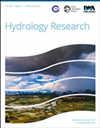Frazil ice events: Assessing what to expect in the future
IF 2.4
4区 环境科学与生态学
Q2 Environmental Science
引用次数: 1
Abstract
This article addresses the question: What is expected from frazil ice activity in rivers, taking into account the changing climate? It begins with an overview of what frazil ice is and what is required for the occurrence of frazil ice events, namely a supercooled water column. Methodologies to anticipate frazil ice events in the short term are based on air temperature and water discharge, underlining the significance of these two parameters for any predictive methods. Longer-term approaches, calibrated against past events (hindcasting), are used to anticipate frazil ice activity into the future, with indicators such as frazil ice risk, water temperature and frazil volume. Any of these approaches could conceivably be applied to frazil-prone river stretches. To assess climate impact, each location should be treated separately. River ice dynamics can lead to the formation of a hanging dam, a frequent outcome of frazil ice generation in the early winter, causing flow restriction. Flood modeling and forecasting capabilities have been developed and implemented for operational use. More frequent mid-winter breakups are expected to extend the occurrence of frazil ice events into the winter months – the prediction of these will require climate model output to adequately capture month-to-month variability.巴西冰事件:评估未来的预期
这篇文章解决了这样一个问题:考虑到气候变化,对河流中弗拉齐尔冰活动的预期是什么?它首先概述了什么是弗拉齐尔冰,以及弗拉齐尔冰事件发生所需的条件,即过冷水柱。短期内预测弗拉齐尔冰事件的方法是基于空气温度和水流量,强调了这两个参数对任何预测方法的重要性。根据过去的事件(后预测)进行校准的长期方法用于预测未来的弗拉齐尔冰活动,包括弗拉齐尔冰风险、水温和弗拉齐尔体积等指标。这些方法中的任何一种都可以应用于容易发生弗拉齐河的河段。为了评估气候影响,应分别对待每个地点。河流冰动力学会导致悬坝的形成,这是初冬弗拉齐尔冰生成的频繁结果,造成流量限制。已经开发并实施了洪水建模和预测功能,以供操作使用。更频繁的隆冬解体预计将把弗拉齐尔冰事件的发生延长到冬季——对这些事件的预测将需要气候模型的输出来充分捕捉逐月的变化。
本文章由计算机程序翻译,如有差异,请以英文原文为准。
求助全文
约1分钟内获得全文
求助全文
来源期刊

Hydrology Research
Environmental Science-Water Science and Technology
CiteScore
5.30
自引率
7.40%
发文量
70
审稿时长
17 weeks
期刊介绍:
Hydrology Research provides international coverage on all aspects of hydrology in its widest sense, and welcomes the submission of papers from across the subject. While emphasis is placed on studies of the hydrological cycle, the Journal also covers the physics and chemistry of water. Hydrology Research is intended to be a link between basic hydrological research and the practical application of scientific results within the broad field of water management.
 求助内容:
求助内容: 应助结果提醒方式:
应助结果提醒方式:


